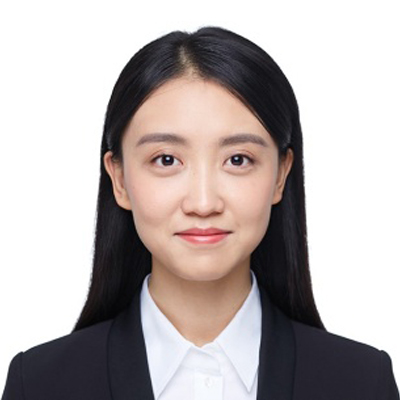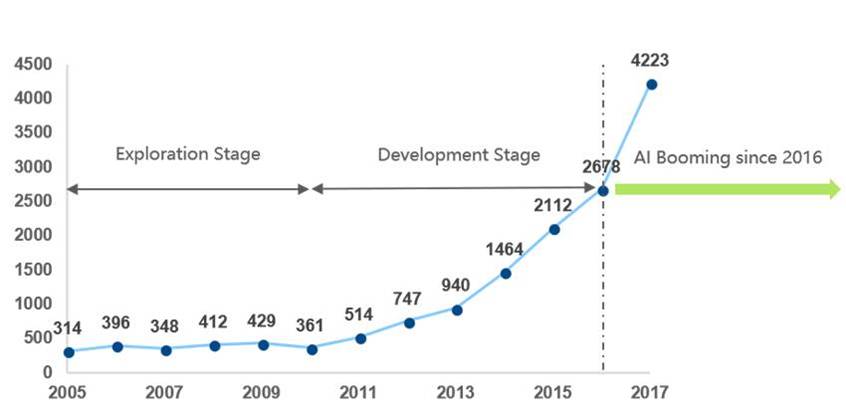 |
Author: LI,Yue |
 |
Author: ZHANG,Xiaoming |
|
Patent Attorney | Attorney at Law |
Partner | Patent Attorney |
Artificial intelligence (AI) is one of the most important technical fields of our era. Progress in AI technology has shown tremendous potential for benefitting mankind by improving efficiency and savings in virtually all industries. In China, the current explosion of patent activities and the anticipated growth of litigations regarding AI technology make us see an urgent need to devise a comprehensive legal strategy to help our clients better protect and enforce their IPs in AI.
1. Statistics of AI Patent Filing in China

We gathered data to illustrate the AI patent filing trends in China from 2010 to 2018. Before 2010, AI in China was in an exploration stage where most patent applications were filed by several main players in the AI market. From 2010 to 2016, AI went into its development stage where more players entered the market, and the patenting filing number showed an exponential increase. Since 2016, AI has been in a booming stage, showing unprecedented patent filing number.
2. All-Round IP Protection in AI
We are committed to build for you an overall, multi-layered and tailor-made legal strategy to protect your IPs in AI. According to the characteristics of AI field and out of consideration for commercial interests, a combination of various types of IPs including patent, copyright, trade secret, defensive disclosure, trademark and domain name is advised so as to fully prepare for the intellectual property competition in the future.

2.1 Protection by Patent in AI
Briefly, AI systems are trained by large datasets with the aid of machine learning algorithms, to enable them to serve innumerable practical applications, including medical diagnosis expert systems, automated trading systems, and so on.
A specificity of AI patent prosecution lies in that individual solutions in AI patent claims may be not patentable if they do not belong to the technical solutions prescribed by Article 2 of Chinese Patent Law or fall within one of two exclusions of Article 25 of Chinese Patent Law “rules and methods for mental acts” and “methods for the diagnosis or for the treatment of diseases”. More specifically, the exclusion subclause “rules and methods for mental acts” might concern patent regarding “data”, “algorithm” and “business model”, while the exclusion subclause “methods for the diagnosis or for the treatment of diseases” explains itself explicitly. Given this legal context, it is essential to find the right way to avoid these eligibility issues when drafting patents in AI. These strategies will be developed below.
■ Drafting advice for patent application with the subject matter of “data”
Data-based patent should be drafted in a manner that, in addition to the presentation of data, technical features regarding data processing, and their corresponding technical effects should also be described. For example, such data processing features can include technical means such as data storing and indexing to reduce redundancy and achieve efficient management of storage. Other examples can be given as technical features of acquiring, extracting, and classifying data.
■ Drafting advice for patent application with the subject matter of "algorithm"
With inventions of this type, it is critical to include as much comprehensive details as possible regarding how the algorithm provides the functionality and achieves the claimed technical effects from a technical level. We give the following exemplary manners which can be used to help the examiners to identify where the patentability resides: (1) establishing clear technical correlation between specific steps of AI algorithm and the problem to be solved; (2) concretizing essential parameters and data used in AI algorithm by assigning them corresponding physical meaning; (3) introducing hardware when describing the working scheme of algorithms; and (4) emphasizing that the technical solution as a whole can solve the specific technical problems in a specific technical field and achieving the corresponding technical effect by applying the AI algorithm.
■ Drafting advice for patent application with the subject matter of “business model”
It is advised to analyze the AI-related business method to be protected, determining its technical features as well as its non-technical features. When drafting the patent specification, emphasis should be made on the technical means involved in claims, while the non-technical part, like the business model itself, should be described with less significance.
■ Drafting advice for patent application with the subject matter of "diagnosis & treatment"
To prosecute patents in respect to a diagnosis or treatment solutions of diseases involving AI assistance, the device for diagnosis or treatment of diseases belongs to the patentable subject matter. Meanwhile, the specific image or data processing method contained in the AI-assisted medical diagnosis & treatment method is the patentable subject matter. Take medical diagnosis expert systems that emulate the decision-making of physicians for example, we can reside its patentability in the technical description of imaging reinforcement and correction method and data processing method to get diagnosis and evaluation, as well as devices such as sensors and energy transceivers.
2.2 Protection of Copyright in AI
Although it’s not possible to copyright raw data per se, data compilations, including the manipulation and organization of structured datasets, are copyrightable. Such copyrights would include technical manuals, product design drawings, computer software codes, algorithms, platform codes suitable for the field of AI, as well as other variants. To adapt the software protection to the continuous updates, a hierarchy of version control should be put in place and major updates should be registered timely.
2.3 Protection of Trade Secret in AI
Trade secret protection provides a solution to avoid the above-mentioned eligibility issues when patenting AI. Specifically, AI system elements well-suited for trade secret protection may include: training sets, data outputs, neural networks including modular network structure and individual modules; software including underlying AI codes and AI-generated codes; and learning algorithms, backpropagation algorithms and other algorithms. Essential AI elements for a company, such as major training datasets or neural network models, are the subjects of ad hoc protection.
2.4 Defensive Disclosure in AI
In the field of AI, IP protection needs both high intensity due to the accelerated rate of innovation, and cost effectiveness to limit resources spent. Defensive disclosure is useful in this context. As the industry players commonly obtain wide-ranging patents, defensive disclosure will prevent competitors from filling excessively broad-range claims, protect your operational capacity and lower your litigation risk. By softening the scope of patent eligibility, defensive disclosure will allow your innovation to expand for every actors. "Time Stamp Authority (TSA)" provides public time stamp for defensive disclosure, and makes powerful prior art defense in litigation.
AI is more than a product, and it’s a product generator. Open-source is one way to exercise defensive disclosure. More than a protection, companies will share the sources of their AI to create foundations for other people to innovate on, to gather a growing ecosystem of users, and to build markets to later capitalize on. Major recent trends of open-source include Amazon’s Alexa open-sourced in 2015, Google’s TensorFlow open-sourced in 2015, and Microsoft’s Computation Network Tool Kit (CNTK) opened in 2016.
2.5 Protection of Trademark in AI
Many companies in AI field provide products and services across the entire AI framework. For example, a company which manufactures AI Chips on the infrastructure layer, may also provide natural language processing platform on the enabling technology layer, and have market share on voice assistant and AI robots on the application layer. To gain the broadest market share, it is essential for companies to manage their trademarks in a coordinated manner horizontally and vertically, in all sectors and on all layers they are positioned in. Trademarks corresponding to different technical layers shall work efficiently as distinctive identifiers, and cross-layers coordination will optimize the overall branding strategy.
2.6 Protection of Domain Name in AI
“A.I.” is now clearly recognized by the average consumers as standing for some kind of smart or AI-related features. More and more products are incorporated with AI features and make the “AI” brand a trending topic. The “.ai” domain name is part of this brand building strategy. Registering “.ai” domain names are substantial not only for those who are principally identified as high-tech companies, but for all market participants who deliver their goods or service in the virtue of AI.
AI-related legal framework is still under debate and evolving with the rapid evolution of AI technology, to define a set of rules that will best suit the up-to-date innovations. We are dedicated to keep up with the development and progress of AI legal protection and provide corresponding service strategy for clients.



